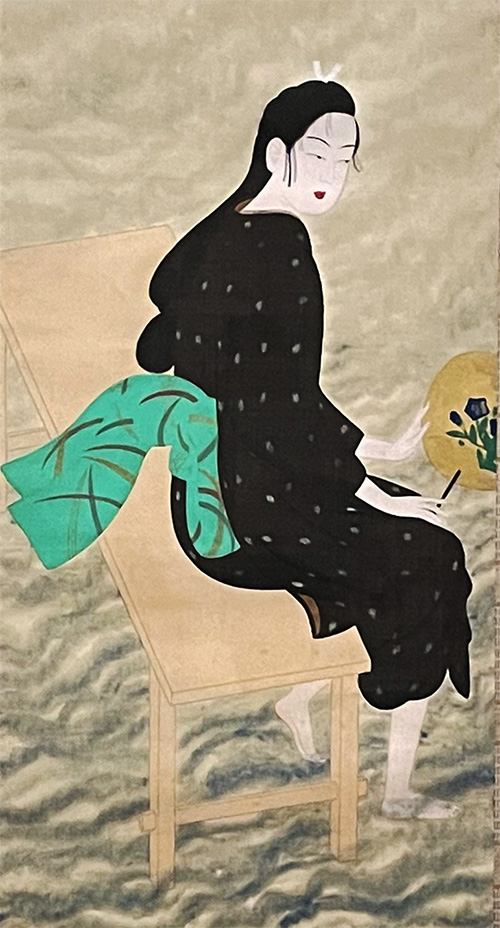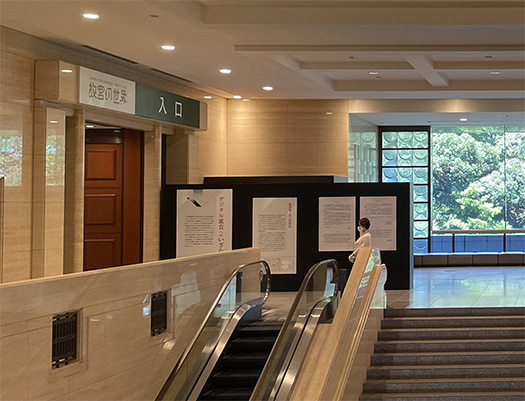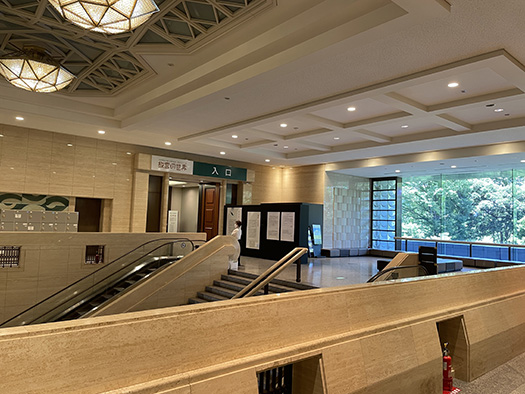
昨日は今回のひとつの目的。長時間の講演会イベント参加。
で、空いている午前中、美術館巡り。やはり美への素朴な思いというものはある。
こういう心情には自分自身で抗いがたい、数寄。
で、ほぼ欠かさず訪れるのが広尾の山種美術館であります。
日本画のコレクションではたぶん日本を代表する美術館ではないか。
今回の展示テーマは「水のかたち」。
―《源平合戦図》から千住博の「滝」まで―
特集展示:日本画に描かれた源平の世界
ということですが、どの展示も圧倒的な訴求力ですばらしい醍醐味。
千住博さんというのは海外で活躍されている日本人画家で
いま現代、リアルタイムでの日本人の美感探究。
「滝」という著名作品がきわめつけとして展示されていました。
これは白と黒のモノクローム表現なのですが、
「ウラ展示」として、カラーでの同様表現もあって興趣を起こさせた。
また、源平合戦図という超大作障壁画もあって、引き込まれる。
まことに日本人の美感の連続性を強く感じさせてくれます。
個人的には奥村土牛さんが渦潮を描いた「鳴門」作品と対比的な
石田武「鳴門海峡」の迫力にはしばし、時を忘れさせられていました。
で、そういう展示作品群のなかで「撮影してもいいですよ」
というサービス展示が1点あるのがこの美術館のウリで、今回は
小林古径「河風」。
美術館のFacebookページでは
「団扇を手に縁台に座り、足先を水に浸して涼をとる娘。
髪型や着こなしは菱川師宣や喜多川歌麿などの美人画を連想させますね。
表具屋から紹介されて奥村土牛が愛蔵していたんですよ。」という紹介。
いかにも庶民的な若い日本女性の美感がピンナップされている。
とくに左足がちょっと水から出ている箇所に、
夏の日本女性の「しぐさ記憶」を官能的にくすぐってくれる。
着物は地味な模様で逆に「素肌感」をつよくコントラストさせている。
足下を流れる水の表情には、そうか、こんなふうな見方もあるんだ、
という一種意表を突いている部分もある。
なによりも女性の顔の表情は、伝統的な民族的な美そのもの。
やはり日本人はこういう透明感に圧倒的に癒される。


一方、対照的だったのが東京国立博物館での
日中国交回復50周年記念の「故宮の世界」展示。
写真は展示会場「平成館」2階の入口周辺の様子ですが、
休日とは思えないほどの閑散ぶりでスタッフのみなさんも手持ち無沙汰。
だいたいチケット窓口で「展示はCG画像展示でほとんど実物はありませんよ」
と予防的に案内をしている始末であります。
・・・、というのが見学しての感想でありました。
English version⬇
Japanese people’s sense of coolness and beauty “KAWAKAZE” by KOBAYASHI Kokei.
A girl sits on a porch with a fan in her hand, dipping her toes in the water to cool off, reminiscent of the beauty paintings of Hishikawa Shisen and Utamaro. The eroticism inherited by the people of Japan. …
Yesterday was one purpose of this event. Attending a long lecture event.
In the morning, when I had free time, I visited art museums. After all, there is such a thing as a simple desire for beauty.
These feelings are irresistible to me, Suki.
I am a regular visitor to the Yamatane Museum of Art in Hiroo, which is probably the most representative collection of Japanese-style paintings.
It is probably the leading museum in Japan in terms of its collection of Japanese-style paintings.
The theme of this year’s exhibition is “The Shape of Water.
-From “Battle of Genpei” to “Waterfall” by Hiroshi Senju, the theme of this year’s exhibition is “Forms of Water.
Feature Exhibit: The World of Genpei as Depicted in Japanese Paintings
Each of the exhibits is overwhelmingly appealing and a true delight.
Hiroshi Senju is a Japanese painter who is active overseas.
His work “Waterfall” is the best example of his exploration of Japanese aesthetics in real time.
His work titled “Waterfall” was the most prominent work on display.
It is a black and white monochrome work.
The “behind-the-scenes” exhibit included a color version of the same work, which was very interesting to see.
There was also a very large painting of the Genpei wars, which drew visitors in.
It was truly a strong reminder of the continuity of the Japanese sense of beauty.
Personally, I was impressed by Okumura Togyu’s “Naruto” work depicting the whirlpools and the contrasting
The power of Takeshi Ishida’s “Naruto Straits” contrasted with Togyu Okumura’s “Naruto” work depicting the whirlpools made me forget the time.
Among the exhibited works, there is one work that is free to be photographed.
Among such exhibits, one of the specialties of this museum is that there is one work that is “free to photograph”.
This time it was “Kawakaze” by Kobayashi Kokei.
On the museum’s Facebook page
A girl sits on a porch with a fan in her hand, dipping her toes in the water to cool off.
The hairstyle and the way she is dressed are reminiscent of the paintings of beautiful women by artists such as Hishikawa Shisenobu and Kitagawa Utamaro.
It was introduced to me by a tableware maker and was in the collection of Okumura Togyu.” The introduction of “Okumura Togyu,” a young and very popular artist.
The work is a pin-up of the beauty of a young Japanese woman in a very folksy manner.
Especially, the left foot is slightly out of the water.
The kimono is a simple pattern, and the image is reversed.
The kimono’s subdued pattern contrasts strongly with the sense of “bare skin.
The expression of the water flowing beneath her feet is a kind of surprise.
The expression of the water flowing under the feet is also a kind of surprise.
Above all, the expression on the woman’s face is the very essence of traditional ethnic beauty.
Japanese people are overwhelmingly healed by this kind of transparency.
On the other hand, a stark contrast was the “World of the NPM” exhibition at the Tokyo National Museum
The photo shows the entrance area on the second floor of the Heiseikan, the venue for the exhibition.
The photo shows the entrance area on the second floor of the Heiseikan, where the exhibition was held.
It was so deserted that it was hard to believe that it was a holiday.
The ticket window was usually staffed with a precautionary warning that the exhibition was a computer-generated image display, and that there were almost no actual items on display.
The staff was so busy that it was hard to believe that it was a holiday.
I was very impressed with the exhibition.
Posted on 8月 1st, 2022 by 三木 奎吾
Filed under: こちら発行人です, 日本社会・文化研究







コメントを投稿
「※誹謗中傷や、悪意のある書き込み、営利目的などのコメントを防ぐために、投稿された全てのコメントは一時的に保留されますのでご了承ください。」
You must be logged in to post a comment.